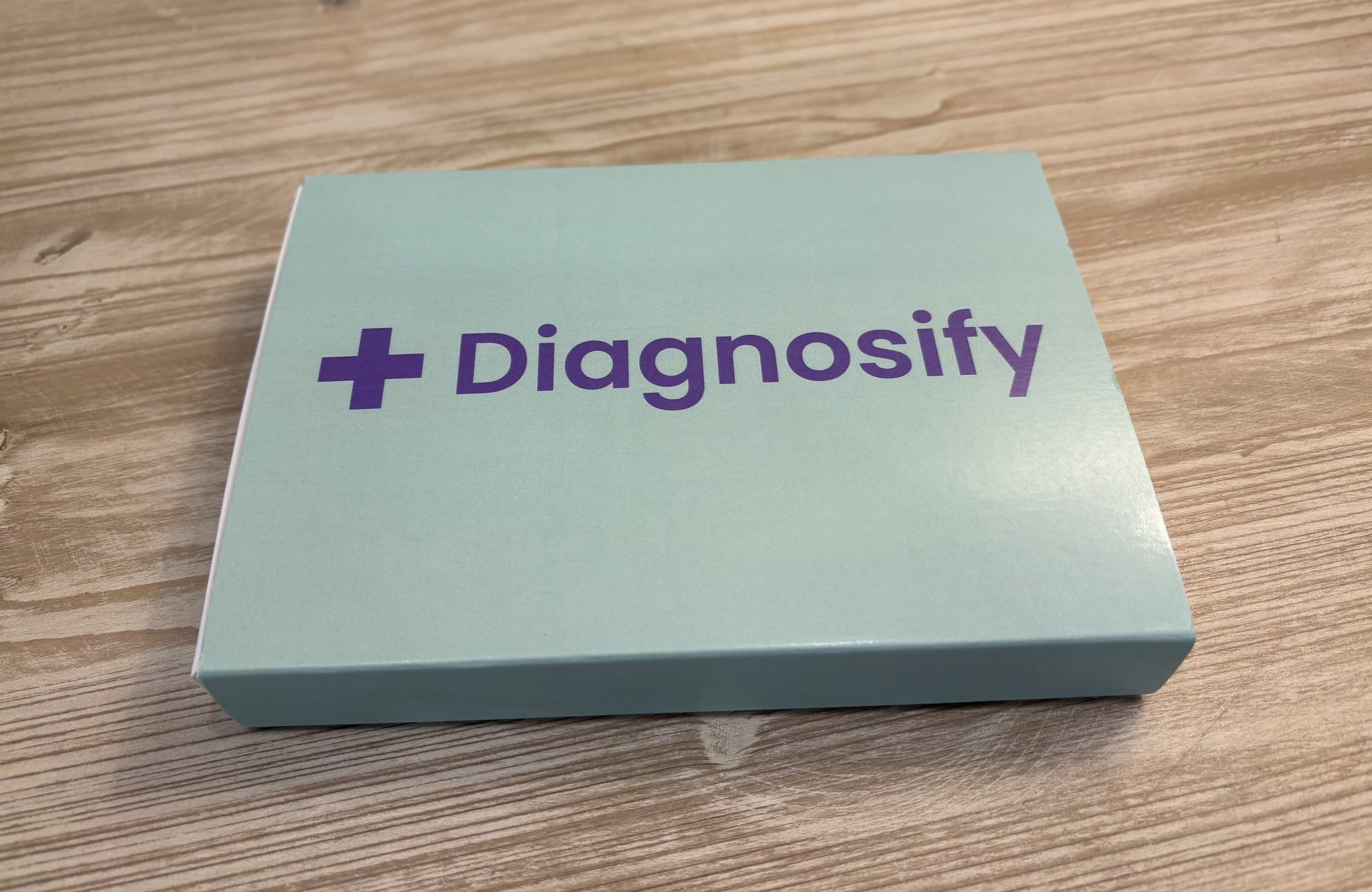Iron Blood Test
Venous & Capillary Blood Sample
5 Biomarkers - Ferritin, Iron, Total Iron Binding Capacity, Trasferrin Saturation, Unsaturated Iron Binding Capacity.
Get a full picture of your iron status with our easy test which checks for signs of iron deficiency, iron overload, and can tell you if your iron levels are in the normal range.
Results within 2 working days
Free delivery
Venous & Capillary Blood Sample
5 Biomarkers - Ferritin, Iron, Total Iron Binding Capacity, Trasferrin Saturation, Unsaturated Iron Binding Capacity.
Get a full picture of your iron status with our easy test which checks for signs of iron deficiency, iron overload, and can tell you if your iron levels are in the normal range.
Results within 2 working days
Free delivery
Venous & Capillary Blood Sample
5 Biomarkers - Ferritin, Iron, Total Iron Binding Capacity, Trasferrin Saturation, Unsaturated Iron Binding Capacity.
Get a full picture of your iron status with our easy test which checks for signs of iron deficiency, iron overload, and can tell you if your iron levels are in the normal range.
Results within 2 working days
Free delivery
Limitations of the test
Read before you order:
Ferritin levels may be raised with conditions such as infection, inflammation, liver or renal conditions, or chronic alcohol consumptions. However, our test also checks an inflammatory marker (hs-CRP) to help distinguish between some of these causes.
FAQ’s
-
The blood test measuring Ferritin, Iron, Total Iron Binding Capacity (TIBC), Transferrin Saturation, and Unsaturated Iron Binding Capacity (UIBC) provides a comprehensive evaluation of iron metabolism in the body. These biomarkers are key to diagnosing and managing conditions related to iron deficiency, iron overload, and anemia. Here's a breakdown of the benefits of each biomarker:
1. Ferritin
Iron Storage Indicator: Ferritin is a protein that stores iron in the body, and its levels reflect the body’s iron stores. It is primarily found in the liver, spleen, and bone marrow, and serves as a buffer against iron deficiency or overload.
Assessment of Iron Deficiency: Low ferritin levels are often one of the first signs of iron deficiency, even before changes in hemoglobin or red blood cell counts occur. It is considered a sensitive marker for iron deficiency anemia.
Monitoring Iron Overload: High ferritin levels can indicate iron overload conditions like hemochromatosis (a genetic disorder where the body absorbs too much iron), or it could be a sign of inflammation, as ferritin is an acute-phase reactant and can increase during inflammation or infection.
Tracking Treatment Progress: Ferritin is commonly used to monitor the effectiveness of iron supplementation or other treatments aimed at correcting iron imbalances. It helps gauge how well the body is replenishing iron stores.
2. Iron
Direct Measurement of Circulating Iron: The iron test measures the level of iron in the blood that is available for use by the body, primarily for the production of hemoglobin in red blood cells.
Identifying Iron Deficiency or Excess: Low iron levels can lead to iron deficiency anemia, which causes symptoms like fatigue, weakness, and paleness. Elevated levels of iron can suggest iron overload, which can damage organs if left untreated.
Assessing Iron Status: Alone, the iron level is not enough to determine whether there is an iron deficiency or overload, but when combined with other tests (like ferritin and TIBC), it can help healthcare providers understand the underlying cause of abnormal iron levels.
3. Total Iron Binding Capacity (TIBC)
Measure of Blood's Ability to Bind Iron: TIBC refers to the total amount of transferrin (a protein that carries iron in the blood) that can bind iron. It provides an indirect measure of the body's ability to transport iron.
Detecting Iron Deficiency: When iron levels are low, TIBC tends to be high because the body increases transferrin production to maximize iron binding and transport. This is a common finding in iron deficiency anemia.
Distinguishing Between Different Types of Anemia: TIBC is often used in conjunction with other iron tests to help differentiate between different types of anemia. For instance, in iron deficiency anemia, both TIBC and transferrin levels are elevated, whereas in anemia of chronic disease, TIBC is usually low.
Evaluating Iron Overload: In cases of iron overload, TIBC may be normal or low because the body is already saturated with iron, and less transferrin is needed for transport.
4. Transferrin Saturation
Indicator of Iron Availability: Transferrin saturation is calculated by dividing the iron level by the TIBC, giving the percentage of transferrin that is carrying iron. This value helps assess how much of the transferrin in the bloodstream is actually bound to iron.
Iron Deficiency and Overload: A low transferrin saturation (typically less than 20%) indicates iron deficiency, while a high transferrin saturation (greater than 50%) can suggest iron overload or conditions like hemachromatosis.
Guiding Treatment: Transferrin saturation provides an additional perspective on iron status, helping healthcare providers fine-tune the diagnosis of conditions like iron deficiency anemia and iron overload disorders.
5. Unsaturated Iron Binding Capacity (UIBC)
Available Binding Sites for Iron: UIBC measures the amount of transferrin that is not currently bound to iron. It gives an estimate of the unoccupied iron-binding sites available in the blood.
Assessment of Iron Deficiency: In cases of iron deficiency, UIBC is typically elevated because there are more available binding sites on transferrin. The body produces more transferrin to maximize iron transport and uptake.
Complementary to TIBC and Transferrin Saturation: UIBC, along with TIBC and transferrin saturation, helps healthcare providers understand the overall iron transport capacity in the body. Together, they allow for a more accurate diagnosis of iron deficiency anemia and iron overload conditions.
Supporting the Diagnosis of Anemia: Elevated UIBC is usually associated with iron deficiency anemia, while a low UIBC can be seen in iron overload or anemia of chronic disease.
Combined Benefits of Ferritin, Iron, TIBC, Transferrin Saturation, and UIBC Tests:
Comprehensive Evaluation of Iron Status:
These five biomarkers provide a thorough assessment of iron metabolism and storage, helping healthcare providers identify whether a person has an iron deficiency or iron overload. They work together to offer a clear picture of iron dynamics in the body.
Ferritin and iron levels give direct insights into the body's iron reserves and circulating iron. TIBC, transferrin saturation, and UIBC help assess the capacity of the body to transport and use iron, which is crucial in diagnosing iron-related disorders.
Early Detection of Iron Deficiency or Iron Overload:
Iron deficiency is the most common cause of anemia worldwide. The combination of low ferritin, low iron, high TIBC, low transferrin saturation, and high UIBC is indicative of iron deficiency anemia, which can be detected early and treated before it causes serious complications.
Iron overload conditions, such as hemochromatosis, can be identified by high iron levels, high transferrin saturation, and low TIBC or UIBC, enabling early intervention to prevent organ damage from excess iron.
Differentiating Between Types of Anemia:
These biomarkers are essential in differentiating between iron deficiency anemia and anemia of chronic disease. In iron deficiency anemia, ferritin is low, TIBC is high, and transferrin saturation is low. In anemia of chronic disease, ferritin levels may be normal or elevated, and TIBC is low.
The test results can also help differentiate between functional iron deficiency and absolute iron deficiency, guiding appropriate treatment decisions.
Guiding Treatment and Monitoring:
For individuals diagnosed with iron deficiency anemia, these tests are used to guide iron supplementation, either orally or intravenously. Ferritin and transferrin saturation can be used to monitor the effectiveness of treatment by checking if iron stores and transport are improving.
In cases of iron overload, tests like serum iron and transferrin saturation help determine the extent of iron accumulation, and may be used to monitor the response to treatments such as phlebotomy or iron chelation therapy.
Evaluating Overall Health and Risk:
These tests help evaluate iron metabolism in the context of various health conditions, such as chronic inflammation, liver disease, kidney disease, and malnutrition. Monitoring iron levels can provide insight into how these conditions are affecting the body’s iron balance.
Regular testing of iron-related biomarkers is also important for people with chronic diseases, heavy menstrual cycles, pregnancy, or those on a vegetarian or vegan diet, as they may be at higher risk for iron deficiency.
Monitoring and Diagnosing Iron-Related Disorders:
Conditions like hemochromatosis (iron overload disorder), iron deficiency anemia, and other anemia types can be detected early and monitored over time, improving management and reducing the risk of complications.
The test helps in diagnosing rare disorders like transferrin deficiency and iron metabolism disorders, which can be challenging to identify without a comprehensive assessment of iron biomarkers.
Summary:
The blood test measuring Ferritin, Iron, Total Iron Binding Capacity (TIBC), Transferrin Saturation, and Unsaturated Iron Binding Capacity (UIBC) provides essential insights into iron metabolism, storage, and transport in the body. These tests are crucial for:
Diagnosing and differentiating between iron deficiency anemia and iron overload disorders like hemochromatosis
Monitoring iron supplementation and managing iron-related conditions over time
Understanding iron dynamics in patients with chronic diseases, liver disease, or other conditions affecting iron balance
Guiding treatment decisions and preventing complications associated with iron deficiency or excess
Together, these biomarkers offer a comprehensive tool to assess and manage iron health, providing valuable information to optimize treatment plans and improve overall health outcomes.
-
Our easy finger-prick iron test or venous blood test checks several biomarkers to give you a full picture of your iron levels. As the iron level in your blood fluctuates daily, based on the iron you get from your diet, this test also measures ferritin — a protein used to store iron in your body. Ferritin is almost always the best measure of your iron status as it’s more stable.
-
Low iron levels are most commonly caused by blood loss, such as heavy periods or internal bleeding (often in the digestive tract). You're at greater risk if you regularly take steroids, blood thinners, or drugs like ibuprofen. Other causes of iron deficiency include pregnancy, a low-iron diet, or bowel conditions like coeliac disease and inflammatory bowel disease.
-
Iron is an essential mineral that’s needed to make haemoglobin, a protein found in red blood cells that helps transport oxygen around your body. It also plays an important role in supporting your immune system, maintaining energy levels, and regulating body temperature.
When your iron level is low, you can feel tired and be more susceptible to illnesses and infections. And a severe lack of iron could lead to iron deficiency anaemia, which causes fatigue, shortness of breath, and heart palpitations.
-
Your iron levels fluctuate daily according to your diet. For this reason, ferritin, a measure of your iron stores, is often a more useful marker of your iron status.
For everyone, a ferritin level less than 30 micrograms/L confirms iron deficiency. However, this threshold may be higher in people with chronic inflammatory conditions, where ferritin levels may be falsely raised.
-
If your diet is contributing to low iron levels, you can try eating iron-rich foods like dark-green, leafy vegetables and meat (if it’s in your diet). Drinking citrus juices alongside a meal including green leafy vegetables can also help improve absorption.
N.B. Choose preferred blood taking kit at checkout.




